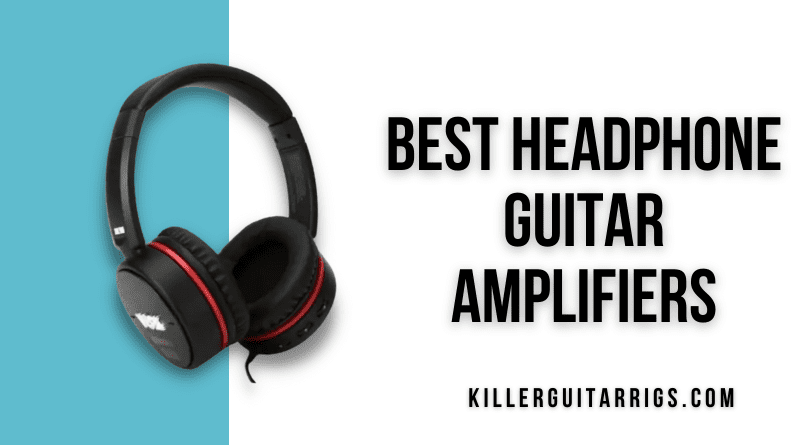Like so many guitar gadgets, headphone amps have come a long way since their first introduction – just as the new breed of headphones made to play guitar through are better at handling distortion and volume.
Early headphone amps for guitar were little more than novelty items (much like early battery-powered amps), but many of today’s examples can now be considered to be serious equipment, with features like loopers, drum tracks, and multi-effects now commonplace.
In this KillerGuitarRigs Review we’ll be rounding up our favorite headphone amplifiers for guitar on the market today. Each amp will be reviewed based on sound quality, features, and battery life.
Read more about our review process.

Line 6 Pocket POD
Features: 300+ Presets, 32 Amp models, Built in tuner
Benefits: Incredible array of effects, Great sound quality, Works as USB interface
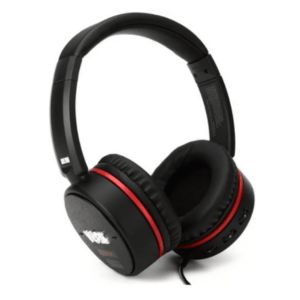
Vox Rock Guitar Headphones w/Effects
Features: Audio Technica speaker drivers, Built in chorus/delay/reverb, 3 Amp models
Benefits: Excellent battery life, All in 1 convenience, Great sound quality

LEKATO Headphone Guitar Amp
Features: Bluetooth in, USB Rechargeable, Built in tuner
Benefits: Supports 3rd party IRs, Ultra compact, Allows for wireless backing track use over Bluetooth
Contents
Our Top 3
The VOX VGH Rock Guitar Headphones were our top pick. Anybody looking for a well-made, feature-packed headphone guitar amp can have it all with this model. Featuring a range of amp modes and FX inspired by famous Vox amps, there are tons of sound combinations that are possible with this convenient true headphone amp.
The Lekato Guitar Headphone Amp is our best budget pick. It comes with multiple effects modules, as well as cabinet and amp models, and operates on a rechargeable Lithium Ion battery. At any price, this is a great choice for any player looking to scale down without sacrificing versatility and portability.
The Line 6 Pocket Pod is our editor’s choice – this is the model to go for if money isn’t an object and you’re looking to get the most possible features and a recognized brand name. It’s loaded with a huge number of presets, amp models, cabinet models, and more. It works as a headphone guitar amp or a multi FX unit just like the larger Line 6 Pod models.
Individual Reviews
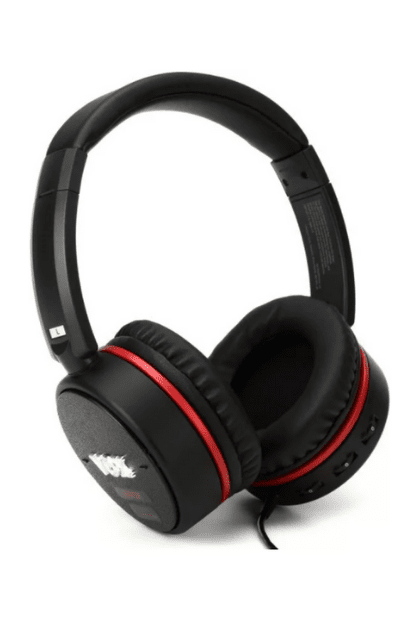
Vox VGH Rock Guitar Headphones
A true headphone amplifier with legendary Vox tones as standard.
With these headohones you're getting the literal definition of a headphone amp. They offer excellent Vox sound quality, and the convenince of an all in one package so you can plug in and play without the need to own a separate amp unit and heapdhones.
If you’ve been looking for a true headphone amp, the Vox VGH Rock guitar amplifier is one of the best on the market. Unlike everything else in this review, this amp is actually built into a set of high-quality headphones.
Unlike the AC30 Amplug that we also covered in this review, the VGH was not actually modeled on an actual Vox amplifier. Nevertheless, we still found that it was full of the crunchy British classic rock tones that Vox is so famous for.
The actual headphone element was made in conjunction with Audio Technica. The overall audio quality was fantastic, with a good range in volume and just the right amount of bass response. They take 2 AAA batteries – the instructions rate these headphones at 16 hours of battery life, and while we didn’t spend quite that long with them, we’re happy to report that the AAA batteries didn’t falter during the test.
Controls were easy to access and could be manipulated without having to remove the headphones, which was a big plus point.
To keep things interesting, this headphone amplifier is equipped with chorus, delay, and reverb, as well as three different amp modes. The FX and amp modes can be mixed and matched to provide an extraordinary amount of variety for an amp that is literally built into its own headphones!
We found that the padding on the headphones was very comfortable and didn’t result in pressure spots on the ears or head. As far as design goes, they’re pretty subtle, in plain black with a red stripe around each can and a chrome Vox logo.
Verdict: The VOX VHG Rock really surpassed expectations. This set was comfortable, lightweight, simple to control and use, and the tones were absolutely superb. Getting through the different FX and amp modes was super easy, making this model an overall pleasure to use and easily one of the best in it’s class.
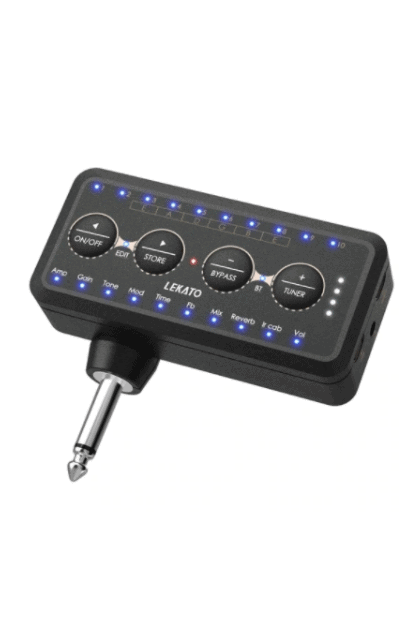
Lekato Guitar Headphone Amp
An unbelievable feature set at an incredible price.
This little unit offers an incredible array of features and even offers modeling capabilities, with 10 different amps and 10 cab sims, giving what is possibly the biggest tonal variety at this price range.
This Lekato headphone amp was one of the biggest surprises of the entire review. This is a definite case of an amp not needing to come from a big-name brand to be feature-packed and great quality.
The first feature we checked out was the tuner. Line-in tuners generally tend to be more accurate than clip-on, so having one built into this headphone amp was super convenient.
Next, we dug into the other features. Being a modeling amp, it was packed with ten different amp models, and 10 “classic cabinet simulations”, making it one of the most versatile headphone amps out there. Of course, there were Fender, Marshall, and Vox simulations in there to cover cleans up to classic rock tones, but there was no guidance as to what exactly everything was supposed to be. Having said that, they all sounded genuinely good.
There was also a bank of chorus, modulation, and phaser FX, together with delay and reverb. To have such a wide range of FX in a bug-style headphone guitar amp was definitely beyond expectations. It isn’t going to replace a full pedal board, but for FX on the go, you can’t do much better, especially at this price.
We got around five and a half hours from a charge of its rechargeable lithium-ion battery pack, which was actually a little over what was advertised. Another unexpected feature of this amp was the ability to connect directly to a computer via USB for recording and further amp simulation. We did give it a go and found that this feature alone is worth the price of the amp. If you want to play with a backing track, it does have an aux-in port, too.
Verdict: Overall, the Lekato Guitar Headphone Amp is a great little amplifier with performance that way surpasses its price. It’s well-made, and the audio quality is excellent. No matter what style of music you play, this Lekato amp has tones you’ll love, and that’s why it’s so deserving of its place as our top value pick.

Line 6 Pocket Pod
Big amp performance without the size and weight.
If you're looking for a tried and tested headphone amp that delivers a huge range of big tones, great build quality, and easy operation, look no further than this Line 6 Pocket Pod. It features over 30 amp models and 16 cab sims, and even gives access to the Line 6 editing suite.
Line 6 is one of the go-to brands when it comes to quality solid-state amps, and it doesn’t just apply to their full-size products. The Line 6 Pocket Pod is a powerhouse, coming with 32 amp models and 16 cabinet models to compliment the 16 effects it ships with.
The tonal variety this allows makes this much more than a practice amp – you could realistically make this a primary amplifier. We loved the awesome selection of sounds built in from cleans to classic rock all the way up to modern high gain amps, but what we loved even more was that it came with access to free Line 6 editing tools and a tone library to update the Pocket Pod as you see fit.
Physically, it was around the size of a handheld tuner, so it was easily able to fit into any gig bag or into our pockets directly, and it did come with a belt clip for convenience while playing. Speaking of tuners, it featured a built-in chromatic tuner with a mute mode to kill output for tuning on stage. The LCD display was clear and very easy to navigate thanks to the 4-way navigation pad. We had the option to run this amp from either 4 AAA batteries or by a 9v DC adapter, which is sold separately.
Verdict: If you’re not concerned about keeping the price down and you’re looking for a fully loaded, 6oz headphone amplifier that thinks it’s a 240-watt Line 6 Spider, you’re looking in the right place with the Line 6 Pocket Pod. It boasts artist-designed tones, classic amp profiles, and will start conversations when people see what it’s capable of.
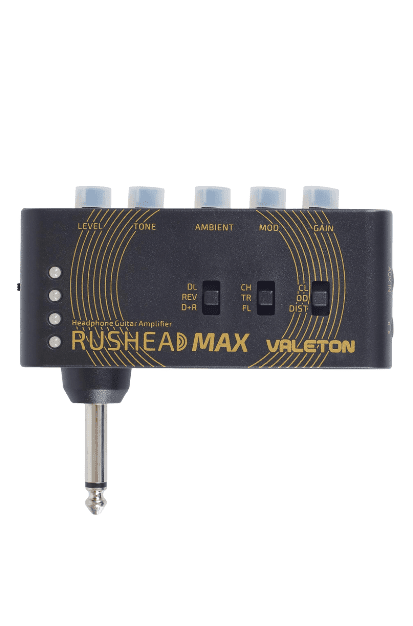
Valeton Rushead Max
A simple to use headphone amp with great tones.
This is a simple headphone amp that does the basics well. It's not packed with amp models or cab sims, but it's reliable, offers USB recharging, and has a great range of tones.
The Valeton Rushead Max is a great little bug-style headphone amplifier for budget-conscious players who aren’t interested in hundreds of FX and just want a good-quality sound with a couple of options to warm up the tone.
It came with delay and reverb for ambience, and flanger, tremolo, and chorus for modulation. There were built-in knobs to control the intensity of these FX, which we thought was a nice touch – often these guitar headphone amps have button adjustments, but the dials allow a lot of control and a tactile feel. In addition to these FX, we were able to switch between clean, overdrive, and distortion.
For practicality, it is charged by USB and runs for about 5 hours after a charge. Being rechargeable, most people will save money on batteries, and this prevents the issue of not having fresh batteries when you need them most!
The interface was extremely simple, with analog controls for all functions. We changed between the available FX using a physical switch, and modified those settings using rotary dials – while some do enjoy digital controls, we find that the feeling of analog switchgear makes it feel more like a regular amp and we thought that would definitely be helpful if you were trying to use this headphone guitar amp for live performance through a speaker.
Verdict: The Valeton Rushead Max is a strong performer and is best suited to guitarists who don’t need, or don’t want digital controls. Both sound and build quality are great, but it would definitely benefit from a folding plug as having it fixed in one position could cause compatibility issues with certain electric guitars fitted with unusually located output sockets.
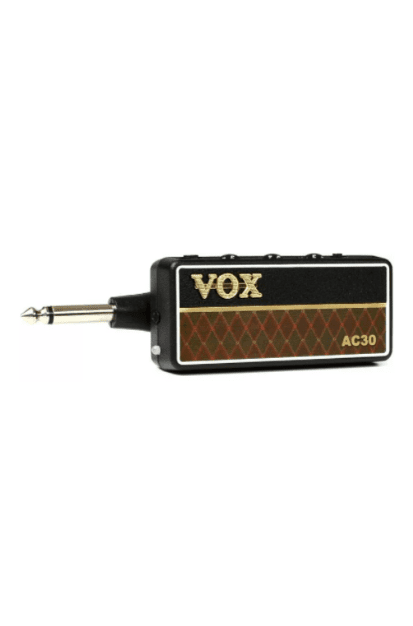
Vox AmPlug AC30
The sounds of the British invasion in the palm of your hand.
If you've ever wanted an AC30, but you don't have the room, the back strength (or the money), this AC30 inspired AmPlug will get you the tones you're looking for. It features a number of FX including chorus, reverb, and delay.
The Vox Amplug AC30 is a tiny solid-state replica of one of the most legendary amps of all time, the Vox AC30. While you won’t be fooling anybody into thinking you’re playing through a high-end tube amp, you will be able to enjoy the sounds of a cranked AC30 and all of the sparkly highs that it’s famous for through the convenience of your headphones.
For texture, it offered 9 different effects, including 3 chorus tones, 3 delay settings, and 3 levels of reverb. While there are headphone guitar amps with more FX built in, with this Amplug AC30, we found that it was like getting a relatively faithful replica of an exotic amp, and the built-in FX complements that modeling rather than mask it.
This unit solved the issue that many of the bug-style headphone guitar amps suffer from – fixed position jacks. The Amplug AC30’s jack rotates through 180 degrees, making it easy to transport, and ensuring compatibility with pretty much any guitar.
It was non-rechargeable, but it squeezed a massive 17 hours of battery life out of its 2 AAA batteries, so we didn’t need to change them all too often. To help preserve battery life, it had an auto-off function that turned the power off when no activity was detected for more than 10 minutes.
For playing along with a backing track, it does offer an aux-in, and for occasions where we wanted to line out to a speaker, we simply needed to plug in a 1/8” cable to the headphone output jack socket.
It’s also worth noting that Vox has a full range of Amplug units, from amp-specific models like this AC30 all the way to digital amps, like the Vox Amplug Classic Rock. There really is something for everyone.
Verdict: The VOX Amplug AC30 has a big name to live up to, and while functionality is limited, everything it does, it does extremely well. The build quality is excellent, and the tones are phenomenal. Operation is straightforward, but on the downside, to switch between FX, you do have to cycle through the various settings using a single button, which can make it difficult to establish exactly which setting you’re on. Besides that, it looks cool and is a great all-round performer.
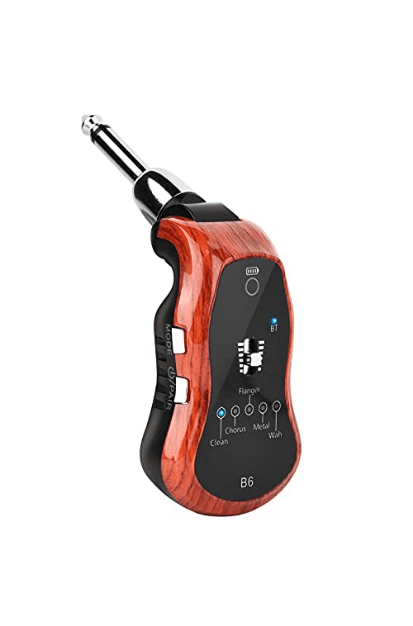
Kithouse B6
Impressive battery life and a long list of features.
This bug style headphone amp delivers big on the basics with nice cleans and ear pleasing overdrive. Couple this with its strong range of built in FX, and you've got a recipe for a solid headphone amp.
The Kithouse B6 was a feature-packed bug-style headphone amp. It came with reverb, flanger, chorus, wah, overdrive, and of course, a clean setting. The clean was surprisingly good, but the biggest surprise was the overdrive which provides a lovely crunch without excessive distortion.
One of the standout features of the B6 was the Bluetooth function, which allowed us to stream music or backing tracks into the amp to jam along through our headphones.
This was a rechargeable amp that ran for a little over 8 hours on a full charge, making it the longest-lasting of the rechargeable amps on test. To cycle through the various FX on this amp, there is a single side-mounted button, and to adjust the levels, we had to use the slider on the front. Kithouse did outfit this guitar headphone amp with display lights that showed at a glance which setting we were currently running, which was definitely a nice touch.
Verdict: The Kithouse B6 is one of those rare, genuinely versatile headphone amps. Tonally speaking, it sounds good, and looks-wise, it’s pretty unique, especially with the wood effect trim. It’s well made, too, although I do feel a dial would have been a better choice for level control than the slider they fitted. It’s one of the easiest headphone amps to use, and the fact that it offers Bluetooth input at such a low price is quite remarkable.
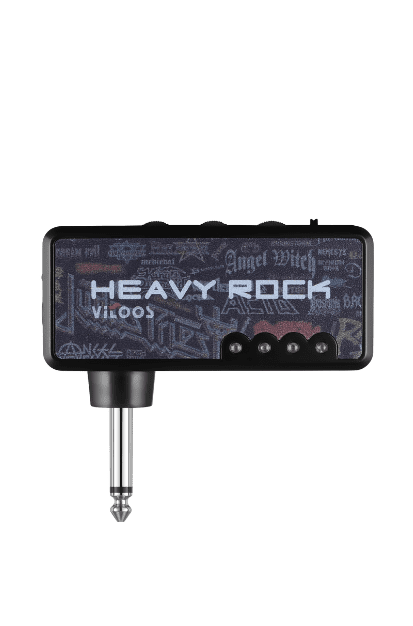
Andoer Vitoos Heavy Rock
All you need to shred on the move.
Catering to fans of heavy genres, this handy headphone amp offers searing high gain tones that check all the boxes for ear pleasing distortion. It even features an aux in for jamming along with a backing track.
Andoer aren’t a big name, but this metal-focused headphone amp really impressed. As far as form factor goes, it was a bug-style amp with a fixed position jack and a tiny body, measuring just 1.5” x 3.4”. After charging this amp to 100%, we got around four hours of use, which is definitely enough to get through most practice sessions.
As for tone, you can probably guess from the name that this was voiced for heavy rock and metal. We found that it offered incredible distortion for such a small unit, which isn’t too common for guitar headphone amplifiers.
The level of distortion was controlled by rotary dials at the top of the unit, which alters tone, volume, and overdrive. We were able to turn down the drive to play clean, but as this amp was voiced for metal, it wasn’t a truly clean sound – something to bear in mind if you are considering this amp. If you want to play with a backing track, this model did feature an aux-in port.
Verdict: The Andoer Vitoos Heavy Rock is a great little headphone amp that offers great tones for anybody looking for a darker sound. The majority of headphone amps for guitar aim for mass appeal and offer a wide range of tones, but Andoer have chosen to drill down to a very specific niche and have made a great little headphone amp for those who strictly play metal.
How to Choose the Right Amp For You
In many ways, shopping for a headphone amplifier isn’t much different from shopping for a regular amp – after all, the features of headphone amps are largely similar to their larger counterparts, albeit compressed to a smaller scale. Let’s next look at some of the common features to be aware of.
Metronomes
Metronomes keep a steady rhythm in the form of continuous clicking. They are great for practicing scales and strumming rhythms.
Drum Tracks
Some headphone amps now carry numerous drum tracks, and some even allow tempo modification. Drum tracks provide a more realistic beat than metronomes do and are great for practicing whole songs or even as accompaniment for solo artists.
Loopers
Loopers record short sections of your playing and repeat them in a loop. Much like drum tracks, they can be used for self-accompaniment and even for creating experimental sounds.
Tuners
Having access to a tuner built into your headphone amp is very convenient and makes it an ideal practice tool. There’s no need to worry about clip-on tuners coming off your headstock, and there’s no need to buy additional line-in tuners.
FX
Effects, or FX, are what separate the cream of the crop from those you might want to look past. In the past, headphone amps for guitar only played dry signals and produced some frankly bland tones. They were OK for practice but were far from inspiring. New headphone amps with built-in FX have a range of sounds and tones also found in standalone pedals and units but in a much more convenient form factor.
Amp Models
Many headphone amps feature modeling technology, allowing you to choose from multiple amp models. In some cases, these are highly accurate models that, when paired with a quality set of headphones, really do sound like the real deal.
What To Look For
While most models have a number of features in common, there are still plenty of options to differentiate between models and appeal to the personal preferences of all guitarists. Below, we’ve highlighted some of those features.
Form
A prime consideration is which style or form factor you’d like to use.
Bug Style
The most common headphone amplifiers are referred to as bug style. Bug-style amps have a built-in 1/4” jack and plug directly into your guitar without the need for cables. They are the most portable of all the headphone amps because they are completely standalone (save for your headphone cord), and are what many would consider the classic guitar headphone amp.
Belt Clip
Alternatively, there are belt clip headphone amps for the guitar. They tend to look like a mini multiFX unit, and for all intents and purposes, they are. The key difference between these units and an actual multiFX processor is that they have a built-in amplifier with a headphone output socket which means they can be used with or without a standalone amplifier. They lose some practicality over the bug-style units due to the fact that you need to run a cable from your guitar to the unit, but they gain it back and more in functions and features.
Headphone Style
There are also true headphone-style amps. With these amps, your headphones directly plug into the guitar, and all of the amp components live inside the cans themselves. These are the most convenient to use, but the drawback is that they can feel quite heavy in comparison to normal headphones, which may cause discomfort during extended use.
Tone
Most guitar headphone amplifier users understand that they aren’t going to rival the tone of a Fender Bluesbreaker or a cranked Tweed Amp with a sub $200 solid-state headphone amp, but there’s no reason for the tone not to be decent for a practice amp. Some headphone guitar amps have been designed to suit certain genres, so, for example, if you play mostly metal, there are guitar headphone amplifiers to suit, the same goes for blues, classic rock, or pretty much any other genre you could think of. There are also some headphone guitar amplifiers that come with multiple amp models – try out a few to find the one that covers what you need.
Power
When considering any portable gear, you need to think about power. Most headphone amps for guitars are battery-powered, although some do have mains power options (which can open you up to background noise). Battery-powered amps will either require disposable batteries or will be equipped with a permanent rechargeable power supply like a rechargeable lithium-ion battery. Remember, while the initial cost of purchasing those that require AA or AAA batteries may be cheaper, they will require regular replacements. Conversely, if your amp is rechargeable only and it dies during play, you may have to stop until it’s charged again.
Connectivity Options
Ensure that any guitar headphone amp you’re considering has the necessary inputs and outputs to connect with your guitar and other devices. Look for a headphone amp with a standard 1/4-inch input for guitars, and see if it has an aux-in for connecting external audio sources that will let you play along with backing tracks.
Portability and Size
If you plan to use your headphone amp on the go, or as a practice amp while you’re away from home, for example, you’ll really want to consider its size and portability. While all of the amps we’ve included today are small, some are still bulkier than others, or may not be suited to being stuffed into a pocket or gig bag pouch. Make sure the one you pick has all of the features you need, while still being portable enough to take on the go.
Controls and User Interface
Look at the ease of use and accessibility of the controls. Are they intuitive and well laid out? Can you access the controls while you’re playing, or do you need to unplug the whole unit to make adjustments? Ensure that the amp allows you to adjust volume, tone, and other features easily.
Final Thoughts
Headphone amps offer a lot of possibilities for almost every player. Not only are they a way to practice quietly without disturbing others, but some can genuinely hold up to semi-professional or even professional use should the need arise.
They can go literally anywhere, and with the advancement of modern technology, many of them sound amazing. It is worth adding the caveat that the quality of the amp sound will depend heavily on the quality of your headphones.
If you’re using budget earbuds, you’ll lose a significant amount of fidelity – if you can, try to play your headphone amp through a pair of studio monitor headphones or in-ear monitors for best results – after all, there’s no sense in putting effort into finding the perfect model, only to kill the tone with low rent earbuds.
So, if you’re in the market for a headphone amp, our top pick, the Vox VGH Rock, delivered great tones at a fair price. If you need to keep costs down, take a look at our best budget pick, the LEKATO Headphone Amp. If budget isn’t a concern, we’d highly recommend our Editor’s Choice, the Line 6 Pocket Pod, due to its wide array of features and fantastic performance.

